Last updated on March 28th, 2024 at 05:36 pm
An HVAC capacitor is a small device that plays a key role in the reliable operation of your air conditioner. It provides energy to an air conditioner during a cooling cycle. It has a very high voltage, and high capacitance and thus is dangerous.
In this blog, we will discuss how to detect a failed capacitor and tips to replace a faulty one.
Table of Contents
You might have heard the term HVAC, but do you know what it means? It stands for Heating, Ventilation, and Air-conditioning. It’s the practice of using a variety of technologies to regulate the temperature, humidity, and purity of air within a confined space.
What is an HVAC capacitor?
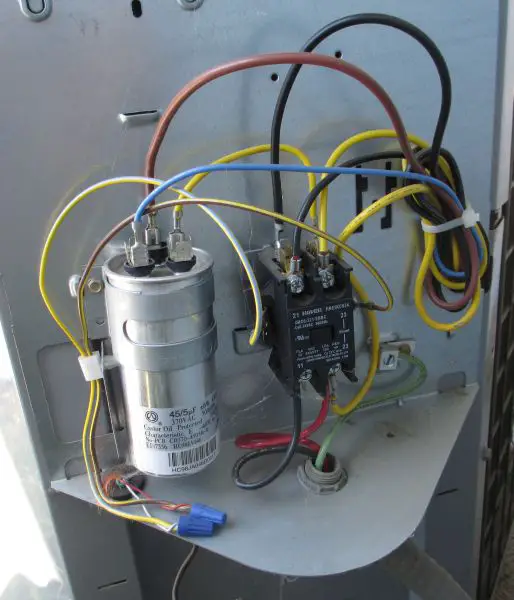
It is a small cylindrical electrical device found inside the cabinet of an air conditioner. It is located near the compressor to store energy and to supply continuous power to the motor (compressor, blower, and outside fan) driving the air conditioning system.
This also helps in stabilizing the voltage through the HVAC system. This normally requires 400 to 600 volts. There are mainly two kinds of HVAC capacitors used in an air conditioner:
- Start capacitor: It provides energy to start the cooling cycle of an air conditioner.
- Run capacitor: It keeps the system running smoothly until the cooling cycle is over.
What does this capacitor do?
An air conditioner requires extra energy to run the motor of an air conditioner successfully. Even if an air conditioner is wired into your home’s electrical system, the energy source is insufficient to turn it ON. Here the HVAC capacitor comes into action to compensate for the lack of energy, by ensuring that your AC has enough energy to perform the job.
What are the values written on the HVAC capacitor?
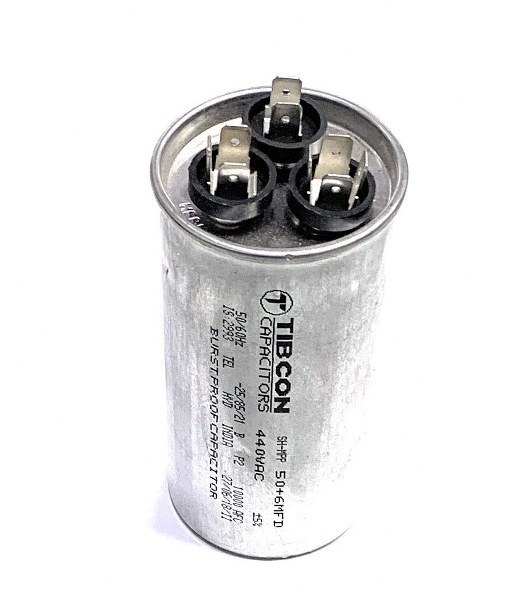
If you look at it (shown in the figure above), you will see a voltage rating, capacitance value, working temperature, and frequency.
- The voltage indicates how much electrical current can flow through the capacitor. If the rated voltage is higher, the electrical current will flow through it at a fast rate.
- The capacitance indicates how much charge a capacitor can hold. Most capacitors have an MFD (microfarads) range of 5 to 80 MFD.
How does it work?
It contains two electrodes connected to opposing terminals of the AC power supply. When an alternating current passes through the electrode, an electric field forms between them, and energy gets stored. Now this stored energy is sent in the form of electrical signals to power the motors in the AC system.
The starting current is between 300 and 500 percent of what the AC typically needs but it gets reduced, once the motors start running. Here the capacitor provides excess power and supplies a constant current for the duration of the cooling cycle after the air conditioner motor has reached the optimum operating speed.
The start capacitor provides extra power (voltage) needed to get the motor started and the run capacitor provides energy to keep them running.
Average lifespan
The lifespan of these capacitors depends on the factors such as heat exposure, usage frequency, etc. Usually, life expectancy lies between 10 – 20 years. Your AC won’t last that long if it over cycles, suffers from high temperature or if the capacitor has a damaged component.
Why do HVAC capacitors fail?
They undergo a significant amount of physical wear and tear. As a result, it is common for them to fail before any other component. Let’s look at some of their failure causes.
Capacitor overheating
Heat weakens the capacitor’s capacity to store an electrical charge. Electrical overheating occurs when an HVAC system runs for a long period.
Note: You can protect the HVAC system by placing it away from the direct sunlight and using reflective blinds on the east and west-facing windows to redirect heat.
Damaged parts
Damaged parts make them less effective by reducing their electric storage capacity and disrupting the flow of current through the AC unit.
Improper voltage rating
While replacing a capacitor, you must ensure that the specifications of the new capacitor match the old one. Or else, there can be chances of capacitor explosion.
Electrical overload
An electrical overload (a current greater than its capacity), can cause the capacitor to fail.
Power surges
The capacitor may lose the ability to store charge and start to degrade as a result of frequent power surges caused by unstable electric lines or power supply.
Note: Installing an HVAC surge protector can protect the AC and capacitors from power surges.
Lightning strikes
A lightning strike from a thunderstorm could overload and damage the HVAC’s electrical system. Thunderstorms lead to power outages, and when electricity is restored, a power surge occurs, which can damage them.
Wear & tear
HVAC capacitor has a lifespan of about 20 years. The functioning of a capacitor degrades over time. Even if it functions perfectly, it will eventually fail due to normal wear and tear.
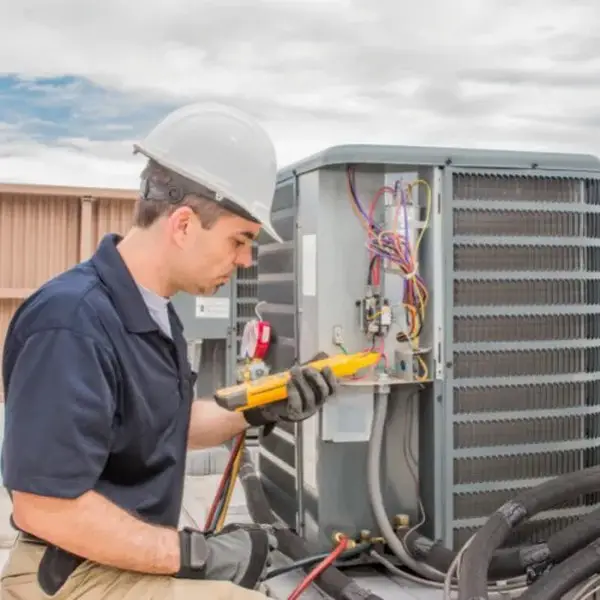
How to detect a faulty capacitor?
A faulty capacitor prevents the external unit from properly functioning, hence slowing the cooling process. So your HVAC unit needs regular servicing. If you see any of the following symptoms, then it could be a sign of a faulty HVAC capacitor.
Insufficient cold air from AC unit (low output)
Your air conditioning system reduces the production of cold air as a result of a defective compressor powered by an AC capacitor.
An unusual humming noise
While turning ON your air conditioner, the HVAC capacitor may start vibrating and emit a humming sound if it runs too quickly or slowly.
Irregularly turning off the HVAC system
There may be a delay in turning on the HVAC system, or it shuts off automatically, or won’t turn on at all.
Expensive Energy Bills
When the cooling system irregularly turns ON and OFF due to a damaged AC capacitor it is considered short cycling. Short cycling causes your monthly energy costs to be higher than usual because the unit repeatedly switches on and off to attain the desired temperature.
A quick way to check the faulty HVAC capacitor:
- Check the air conditioner’s condenser unit. Look for the fan through the vents. If your air conditioner’s fan isn’t spinning, look for a long, thin object (a stick, or a screwdriver). Gently press one of the fan blades. If the fan starts spinning on its own and continues to spin or you hear a humming sound, then your capacitor is defective.
- You can detect the faulty HVAC capacitor with the help of a multimeter. A faulty capacitor will not be able to store enough charge.
- You can also easily detect a faulty capacitor by simply looking at it. It will bulge outwards or/and leak oil.
How to replace an HVAC capacitor?
You can replace it yourself with simple tools and materials. But you should be careful while doing this. As we know capacitors are designed to store electric charge, thus there is a risk of electric shock if you touch them or disconnect them without discharging any current that they hold. You can follow the simple steps given below:
NOTE: We don’t recommend replacing it yourself
Step1: Turn off the power to your air conditioner. It will either be a fuse or an MCB (Miniature Circuit Breaker) located near the condensing unit.
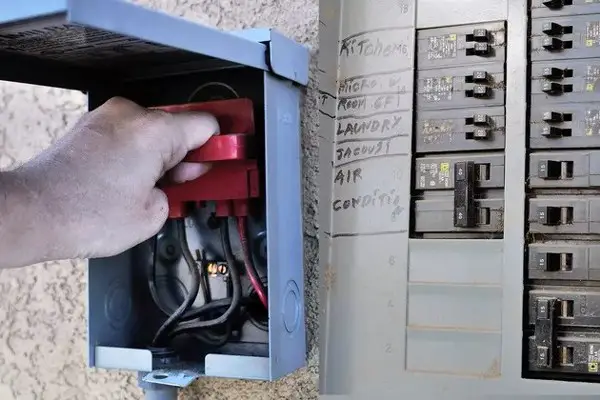
Step 2: Find and locate the control panel of your AC unit and open it by loosening the screws. If you don’t know where the control panel is you can follow the wires which enter the air conditioner. And normally it is located on an upper corner of your air conditioner casing with an electrical warning label on it.
Step 3: Locate the capacitor inside the panel of your air conditioner. Normally it is in a cylindrical shape with specifications like load voltage, capacitance value, and tolerance marked on it. To replace it you have to buy a new one with the same specifications as the old one. Don’t worry if the new one is in a different form, it can still be mounted in the existing location.
Step 4: You have to discharge any energy remaining in the capacitor. For that take a screwdriver and touch the metal end across the two terminals that come out of the capacitor.
Step 5: You have to look closely at the connections of the old capacitor with the wires. You can either take a picture or write it somewhere because connecting the new one in the same polarity is important.
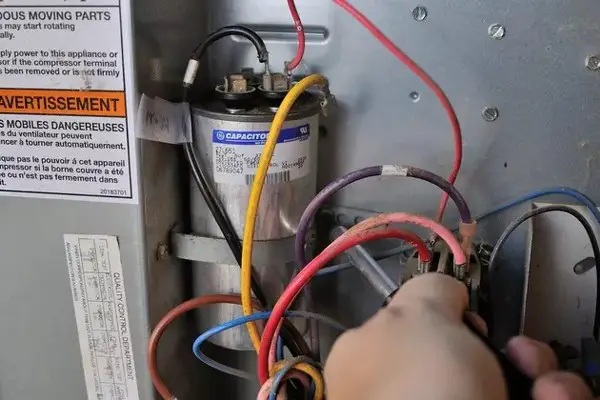
Step 6: Disconnect the wires from the old capacitor and attach the new one to the same place with the correct polarity.
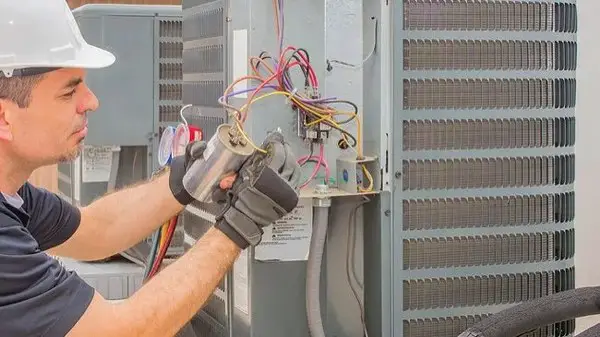
Step 7: Verify again that the wires are connected at the proper place, then verify the connections by slowly pushing on each one. If required, tighten them.
Step 8: Finally, make sure that the capacitor is reinstalled to the appropriate place, and then check the operation of your AC unit by switching on the thermostat. If there are no issues, screw the access cover back in place. You are now ready to reuse your air conditioner.

**Image courtesy: Hunker
How much does it cost to replace an HVAC capacitor?
Based on the data from the home advisor, the cost of replacing a faulty AC capacitor in your air conditioner lies between $120 and $250 including professional installation. The average cost of an HVAC capacitor is $170.
If you want to use a capacitor of the branded model, then the price can increase up to $400 or more. The price for the replacement depends on the model, brand, voltage rating, and labor.
You can replace it yourself but we don’t recommend it. Because a faulty part can give you a shock, leak toxic liquids, or cause serious injury. Even when the power to the AC unit is turned off, capacitors continue to store energy, making them unsafe for you to handle.
It is good to have an experienced HVAC expert to repair it. This will ensure that the job is done correctly and protect an HVAC system from more risk.
Conclusion
Now you all are aware of the significance of an HVAC capacitor. When you use a faulty AC capacitor, you will experience poor cooling and high energy bills. Your air conditioner’s AC capacitor needs to be serviced regularly to function properly. You can easily find varieties of AC capacitors that ensure excellent cooling performance by your air conditioner.
FAQs
What does an HVAC capacitor do?
It stores electrical energy and releases it when needed to power various components within the HVAC system, primarily the compressor and the fan motor.
What happens when an HVAC capacitor gets damaged?
When an HVAC capacitor gets damaged, it can cause motor failure to start, intermittent operation, reduced cooling or heating capacity, overheating of motors, and electrical issues within the HVAC system.
How long do HVAC capacitors last?
The lifespan of HVAC capacitors typically ranges from 5 to 15 years, depending on factors such as usage, environmental conditions, and quality of the capacitor.

Your cost for a capacitor is what the service person charges you, but the actual component cost is between $12 to $20. They mark it up A HELL OF A LOT ,like 10 times the purchase price. The Turbo 200 universal capacitor which can be purchased for $180. This capacitor will cover any uf value. This capacitor can be purchased on, you, where else, Amazon. Just do a search for TURBO 200. Just got back from Ace Hardware, got a 35/5 MFD CAP for my A/C unit for $30, Amazon had the same cap for $12, but I needed to get it today. Still ordered the one from Amazon as a backup. They don’t last as long in hotter climates.